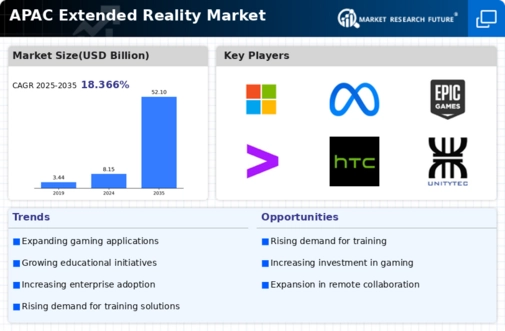China : Unmatched Growth and Innovation
The competitive landscape in China is fierce, with major players like Tencent, Alibaba, and ByteDance leading the charge alongside global giants such as Meta and Microsoft. Cities like Shenzhen are emerging as tech hubs, fostering innovation and collaboration. The local market is characterized by a strong appetite for immersive experiences in gaming, education, and healthcare, creating diverse applications for extended reality technologies.
India : Emerging Market with High Potential
Key markets include Bengaluru, Hyderabad, and Mumbai, where tech hubs are fostering innovation. The competitive landscape features local startups alongside global players like Google and Microsoft. The business environment is increasingly favorable, with a focus on applications in education, entertainment, and real estate, driving demand for extended reality solutions.
Japan : A Leader in XR Applications
Tokyo and Osaka are pivotal markets, hosting major tech companies like Sony and Nintendo. The competitive landscape is characterized by a mix of traditional firms and innovative startups. Local dynamics favor applications in gaming and cultural experiences, with a growing interest in XR for training and simulation in various industries.
South Korea : Strong Infrastructure and Innovation
Seoul is the primary market, hosting major players like Samsung and LG. The competitive landscape is dynamic, with a mix of established companies and emerging startups. The local business environment is conducive to innovation, with applications in gaming, virtual tourism, and education gaining traction, reflecting the country's commitment to becoming a global tech leader.
Malaysia : Emerging Hub for Innovation
Kuala Lumpur and Penang are key markets, with a growing number of tech startups and initiatives aimed at fostering innovation. The competitive landscape includes local firms and international players like HTC and Google. The business environment is evolving, with applications in education, healthcare, and tourism gaining momentum, reflecting Malaysia's ambition to be a regional tech hub.
Thailand : Cultural Richness Meets Technology
Bangkok is the primary market, with a mix of local startups and international players like Meta and Microsoft. The competitive landscape is characterized by a focus on applications in tourism, education, and entertainment. The local business environment is becoming more favorable, with increasing collaboration between tech firms and government agencies to promote XR adoption.
Indonesia : Growing Demand and Innovation
Jakarta and Bandung are key markets, with a mix of local startups and international players like Google and Microsoft. The competitive landscape is dynamic, with a focus on applications in education, gaming, and e-commerce. The local business environment is increasingly favorable, reflecting Indonesia's ambition to become a significant player in the extended reality market.
Rest of APAC : Emerging Markets with Unique Needs
Countries like Vietnam, Philippines, and Singapore are key players in this sub-region, with a mix of local startups and international firms. The competitive landscape is varied, with applications in education, healthcare, and entertainment gaining traction. The local business environment is becoming more conducive to innovation, reflecting the unique needs and opportunities in each market.

















Leave a Comment